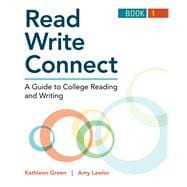The first text in a two-part series for the integrated reading and writing course, Read, Write, Connect, Book 1, offers carefully and thoroughly integrated instruction for reading and writing at the paragraph-to-essay level. With scaffolded pedagogy and a flexible structure that reflects the recursive nature of reading and writing processes, the text allows instructors to easily differentiate instruction to meet the needs of all students. It offers intensive practice in the basic skills of reading comprehension and summary writing, and then helps students build on those skills to respond to texts critically and analytically in their own college-level paragraphs and short essays.
LaunchPad Solo for Readers and Writers can be packaged with Read, Write, Connect, Book 1 at no additional cost,, allowing you to more efficiently track students’ progress with reading, writing, and grammar skills in an active learning arc that complements the book.









